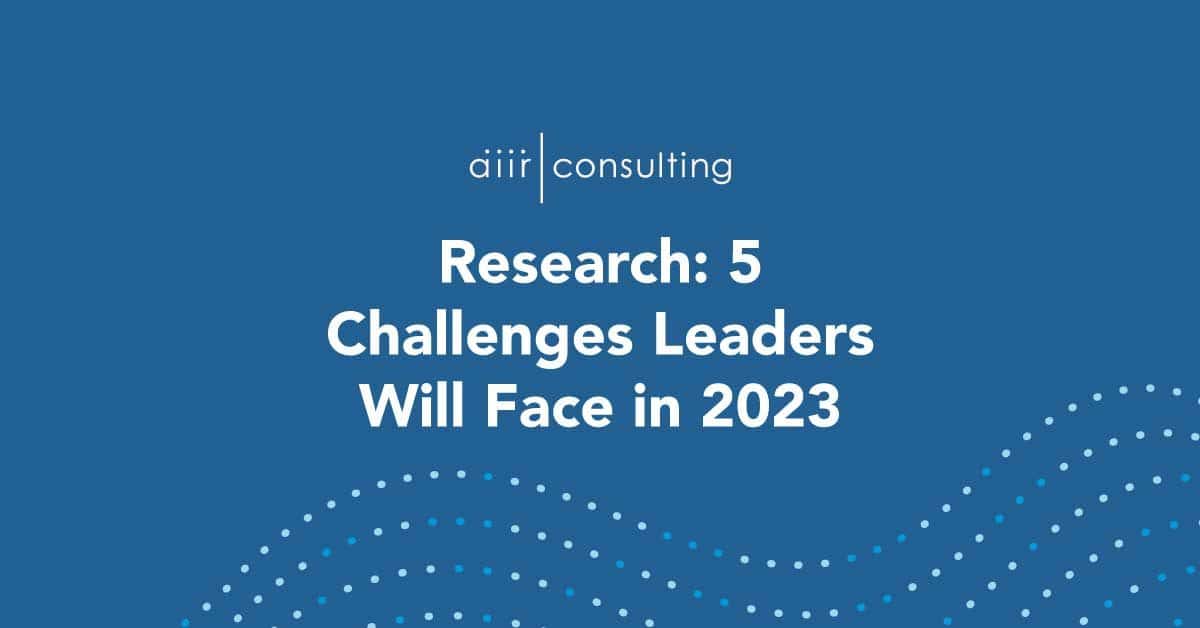
Research: 5 Challenges Leaders Will Face in 2023
December 9, 2022
Data Analysis of the AIIR Leadership 2023 Survey
2022 presented leaders with an unexpected set of challenges, and 2023 won’t be much different. To understand the leadership skills required to meet these challenges, we surveyed more than 136 coaches from the AIIR Global Coaching Network. These senior executive coaches have collectively spent thousands of hours advising leaders and teams at Fortune 1000 companies over the past year.
Based on their experience, our survey data, and decades of leadership research, we have identified the challenges leaders will face in 2023 and the skills they’ll need to overcome those challenges
Methodology
Different from quantitative research methods that rely on the statistical analysis of quantitative data, qualitative research methods are geared toward deriving a focused understanding or description of a topic studied from analyzing qualitative information, such as the open-ended included in our survey (Patton, 2002). Qualitative methods are an often misunderstood and underutilized form of data analysis. Even so, they are widely used across disciplines, industries, and practices (Divan et al., 2017).
Grounded theory is a type of qualitative research that was developed by sociologists Glaser and Strauss in the 1960s (Strauss & Corbin, 1998). Grounded theory is defined as an approach whereby themes emerge from the data and are hence ‘grounded’ in it.
Thus, theories are inductively generated from participants’ descriptions and the researcher’s observations rather than derived from a laboratory or a set of numerical measurements (Patton, 2002). As grounded theory methodology has evolved, a divergent theory style has begun to emphasize a more structural and systematic method for interpreting data. The current study employs this more recent approach to grounded theory introduced by Strauss and Corbin. This method requires interview data to be exhausted through multiple levels of coding to arrive at its conclusions. These levels include open coding, axial coding, and selective coding. The current study utilized a hybrid form of this grounded theory method, conducting open and axial coding only.
First, we began our analysis by coding responses. Codes are a way to standardize disparate pieces of data. Because questions were answered in a free response format, the language and level of detail varied significantly, from a few words to a few sentences. Following the open coding process, our research team entered into the next level of coding, axial coding. Axial coding entails organizing the open codes into higher-order categories or themes. Axial codes were formulated by ordering open codes hierarchically based on the number of sources they had. Thus, if an open code had eight sources, it was more likely that this code would be considered an axial code than an open code that received only one source. During this process, some open codes were merged to form a new axial code. We further grouped the remaining codes into clusters based on their relation to each other. Each group received a label, which became a core theme. Throughout the axial coding process, we continuously referenced back to the actual text of the codes to ensure that the codes accurately represented the participants’ content.
Key Findings
| Theme | Number | Representative Quote |
|---|---|---|
| Countering low morale and burnout | 39 | “2022 saw leaders making the tough decision to reduce the workforce. In 2023, leaders will need to focus on engaging and retaining the workforce that remains and carries greater workloads.” |
| Navigating macroeconomic headwinds and global unrest | 38 | “The war in Ukraine and how it plays out in 2023 will be a significant challenge across countries and industries. The impact will be felt across the globe and make it difficult to avoid or recover from recession.” |
| Reinventing our work paradigm | 36 | “My theory is that many/most of the cultural/social/belonging aspects of the workplace have been removed permanently, and leaders will struggle to create meaning in work for their teams.” |
| Leaner teams needing to outperform, despite doing more with less | 25 | “Economic headwinds will also increase demand on leaders to increase productivity and performance from each employee while at the same time reducing headcount.” |
| More of the same: 2023 will be a continuation of 2022’s negative themes | 17 | “I expect to see all the challenges I observe this year amplified with enormous uncertainty and complexity of leadership tasks.” |
| Challenge of finding and retaining talent will persist | 14 | “Continued rising costs including the rising cost of employee benefits coupled with the need to enhance benefit packages to retain professional talent.” |
Conclusions
While we have yet to discover a Crystal Ball, surveying 136 leadership development practitioners around the world who operate between the levels of CEO to Director is the next best source of information. Undoubtedly, each of these practitioners possess a unique experience and perspective. Analyzing these perspectives through formal qualitative methods yields theme clusters that are compelling, if not predictive of 2023 trends.
Our data points clearly to a need for leaders to brace themselves for another year of challenge and uncertainty. Without taking a proactive approach, consequences range from burnout, team dysfunction, and productivity loss. Successful leaders will more concretely address new ways of working, harnessing community and human-centered leadership to build resilient cultures, and helping people manage ever-accelerating change.